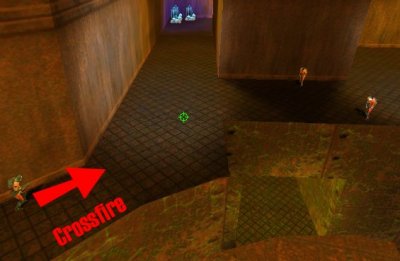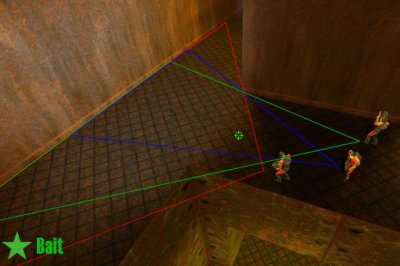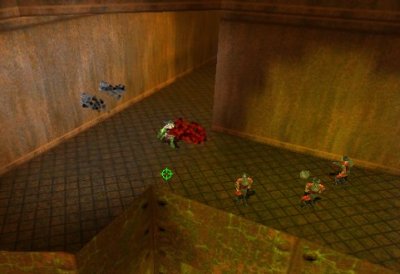
STRATEGIES
overview | the units| the buildings | strategies from the authors
From Stuffy (graphics, levels):
Build your base as fast as you can. Aim to get the Flesh compactor as quickly as possible. Use Gladiators with standground orders as railgun turrets. They have a long range and are great for guarding corridoors. I tend to use Shriekers more than the other developers, and they seem to be useful investments.
Always have a spare Technician. Hide it by parking it up near the roof in a shadow and giving it standground orders. I can't stress how important cameras are. As soon as you start the game, DROP A CAMERA. If you get stuck in a wall (which happens a lot until you get used to the controls) you can switch back to your camera view. Also dump cameras in your opponents bases, don't worry about hiding them, because they can't be destroyed.
I like Mutants as offensive units, because they are nice and fast and have a real good survival rate vs Gladiators. Gunners are pretty good for rushing if you send say, three forward and three behind to lob grenades.
Never underestimate Carriers. You can quickly win a game with a Carrier strike. Don't think of them as one unit - but think of them as a small portable army. Beware Gladiators vs Carriers - they are about 50/50 survival ratios. Parking a Carrier above a doorway is a neat trick too.
With Flamesoldiers, don't go overboard on the numbers of them that you build. They are a great offensive unit, but they tend to kill your troops by accident if you are sloppy with positioning your units.
The levels bundled with QandC (there are seven) are either symmetrical structures or freeform but fun to play. Here is the suggested player load for the levels:
| Level name | Load |
| qandcdm1 - Terminal Head Wound | 4+ |
| qandcdm2 - Ghostdance | 4 |
| qandcdm3 - Hexed | 3 |
| qandcdm4 - Egg's Asylum | 8 |
| qandcdm5 - Slamdance | 4 |
| qandcdm6 - Twist the knife slowly | 4+ |
| qandcdm7 - Electric Eddie's houses of pain | 4 |
From Dr.Teeth (code):
 |
One of the big differences between QandC and other RTS games is the architecture. Use this as much as you can when you play. When trying to set up ambushes, don't just leave a clump of units somewhere and hope for the best. Plan what you are trying to achieve, and act accordingly. One of the easiest ways to improve your chances is to position your units properly, and give them stand ground orders. In this example, the red player has set up their ambushers, but has done so poorly. The marked arrow shows where crossfire from the outlying unit will hit the other ambushers and vice versa. | In the next shot, the red player has set up their units in a more appropriate manner. The triangles show the zones upon which his units may safely interdict. The star indicates a good position to put a bait unit, with stand ground orders, so it could still shoot at the ambushed units, as they ran up the corridor. |
 |
 |
This example shows the result of a properly orchestrated ambush. |
Remember your supporting units. As Stuffy mentioned above, make use of your technicians for what they do best - build and fix. Medics can be an invaluable unit, and in a protracted game, no offensive should take place without a pair of them. While this won't make your force effectively invulnerable, it will allow them to keep fighting for longer. Units with grenades can be very good for controlling stair wells, or when combined with the stand ground/force attack controls can be used to break up waiting ambushes. When attacking, try to break your force into different elements (using the group keys). Try keeping a few gladiators back at first, and then engage them when you can see the tide of the attack.
Aside from specifics, try to also think of the game as a whole. Where are the centres of gravity? (Those areas/assets that the enemy can do least without) Look for vulnerabilities in a player's defence. The maximum effect of an attack can be achieved when a threat meets a vulnerability. If your opponent has left a back door into their base open because it is protected by a large canyon, send some carriers to break through. A side passage may allow you to insert units behind their front lines. Try attacking from different areas at once, use one force to engage units that may have been held back, while a second force breaks through the now weakened defences.
Where possible, take the initiative and dictate the terms of the engagement to your enemy. Taking the intiative does not necessarily mean attack, but can take the form of a canny defence that forces your opponent to maneouver into the teeth of your defence. Use turrets to deny other paths into your base. Alternatively strengthen your attack capabilities early and make the engagement revolve around the face that's most advantageous to you. Through a combination of intiative, surprise, nerve and timely action you can achieve victory. Good luck and most importantly, enjoy yourself.